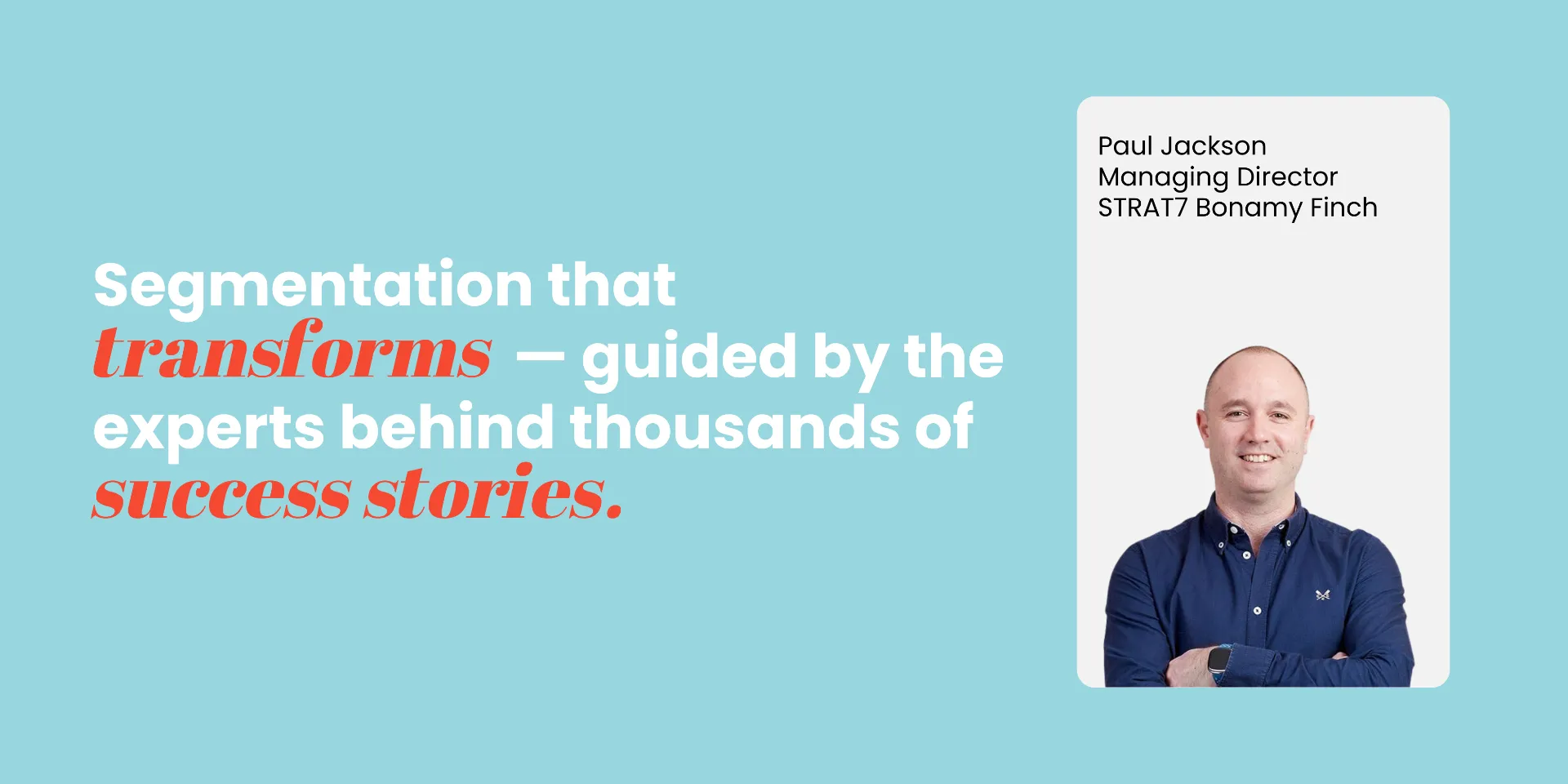You’ve invested time and resources creating detailed customer segments. They look impressive in presentations, and everyone nods appreciatively at the insights. But then what? How do you bridge the gap between interesting customer profiles and practical business action?
The difference between segmentation that sits on a shelf and segmentation that drives results lies in connection. Your segments need to connect to your existing data, your current activities, and your team’s daily workflows. Without these connections, even the most sophisticated segmentation becomes just an expensive academic exercise.
Let’s explore how to make your segmentation immediately useful by linking it to what you already do and the data you already have.
The connection challenge
Many companies approach segmentation in isolation – conducting research, creating beautiful personas, then expecting teams to somehow figure out how to use them. This approach fails because it ignores a fundamental truth: people use tools that make their jobs easier, not harder.
For segmentation to drive results, it must seamlessly integrate with:
- Your existing data systems (CRM, analytics platforms, marketing tools)
- Your current activities (campaigns, customer service, product development)
- Your team’s workflows (how they currently target, measure, and optimise)
The goal isn’t to replace everything you’re doing – it’s to enhance and focus your existing efforts using customer insights.
Connecting to your data infrastructure
Customer database integration
The most powerful connection is linking your segments directly to your customer database. This allows you to:
Identify segment membership: Tag each customer with their segment information in your CRM system.
Track segment performance: Measure revenue, retention, and engagement by segment over time.
Personalise at scale: Use segment insights to customise communications, offers, and experiences automatically.
Measure ROI: Directly attribute business results to segment-focused initiatives.
Making the connection work
Even if your customer database has limited information, you can still create valuable connections:
Demographic matching: Use age, location, or other basic demographic data to predict segment membership.
Behavioural patterns: Look for purchase patterns, engagement levels, or product preferences that indicate segment membership.
Progressive profiling: Gradually collect additional information through surveys, preference centres, or progressive forms to improve segment identification over time.
Real-world example: Travel company success
A travel company created two connected segmentations that transformed their business:
Traveller segmentation: Person-based segments covering enduring relationships with researching and booking holidays.
Trip-based segmentation: Occasion-based segments reflecting how needs change from one trip to the next (cultural city break with partner vs. family beach holiday).
The connection strategy
They linked these segmentations to their customer database and discovered that some segments valued holiday representatives while others didn’t. By analysing which hotels different segments visited, they could:
- Allocate resources strategically: Move more reps to hotels where “rep-loving” customers stayed
- Reduce waste: Remove reps from hotels where they weren’t valued
- Measure impact: Track satisfaction, recommendations, and complaints by segment
The results
- Customer satisfaction increased across both segment types
- Recommendations went up significantly
- Complaints dropped measurably
- Resource allocation became more efficient
- ROI improved substantially
The key was connecting segmentation insights to operational decisions – where to place staff, which services to emphasise, and how to allocate resources.

Connecting across different team activities
Multi-channel fundraising example
A charity we worked with demonstrates how to connect segmentation across different team activities:
The challenge: Three fundraising teams used completely different approaches:
- Face-to-face fundraisers: Only had location and basic demographic information
- Telemarketing team: Worked with phone numbers and donation history
- Online advertising team: Could target using detailed interest and hobby data
The solution: Create segmentation that worked across all three channels:
Simplified segment identification: Develop easy-to-recognise segment characteristics that face-to-face fundraisers could quickly identify and adapt to.
Flexible targeting: Ensure segments could be targeted using basic demographics (for face-to-face), donor history (for telemarketing), and interest data (for online advertising).
Consistent messaging: Create core messages for each segment that could be adapted across all three channels while maintaining consistency.
The connection principles
Right level of detail: Segments needed to be detailed enough to be useful but simple enough that a face-to-face fundraiser could quickly determine who they were talking to and adapt accordingly.
Multiple access points: Each team could use the segmentation through their existing data and tools, not requiring new systems or processes.
Unified strategy: All teams worked towards the same segment-focused goals while using their preferred methods and data sources.
Connecting to current marketing activities
Channel strategy integration
Your segmentation should enhance your existing channel strategy:
Social media: Use segment insights to choose platforms, create content, and time posts for maximum impact with priority segments.
Email marketing: Segment your email lists and customise content, timing, and frequency based on segment preferences.
Content marketing: Create content that addresses the specific needs, interests, and pain points of your target segments.
Paid advertising: Use segment characteristics to improve targeting across all digital platforms.
Campaign development
Transform how you develop and execute campaigns:
Audience selection: Use segments to choose who to target rather than relying on basic demographics or broad categories.
Message development: Create messages that speak directly to segment motivations and remove barriers specific to each group.
Channel selection: Choose channels based on where your segments actually spend time and how they prefer to engage.
Performance measurement: Track campaign success by segment to understand which approaches work best for different groups.
Connecting to product and service development
Innovation pipeline
Use segmentation to guide your product development:
Unmet needs identification: Each segment reveals specific gaps in the market that could drive new product development.
Feature prioritisation: Understand which features matter most to your most valuable segments.
Service design: Create service experiences that match segment preferences and expectations.
Pricing strategy: Develop pricing that reflects the value different segments place on your offerings.
Customer experience optimisation
Touchpoint design: Create different experiences for different segments based on their preferences and expectations.
Support strategy: Train customer service teams to recognise segment characteristics and adapt their approach accordingly.
Onboarding processes: Design different onboarding experiences that match how different segments prefer to learn and engage.
Connecting to sales processes
Sales team enablement
Prospect qualification: Help sales teams quickly identify which segment a prospect belongs to and adapt their approach.
Conversation guides: Provide talk tracks and question frameworks tailored to different segment motivations and concerns.
Objection handling: Prepare responses to the specific barriers and concerns that each segment typically raises.
Proposal customisation: Tailor proposals and presentations to highlight what matters most to each segment.
Implementation: Making connections stick
Start simple
Choose one connection: Begin by connecting your segmentation to your most important current activity – usually customer acquisition or retention.
Pilot and learn: Test with a small team or single campaign before rolling out broadly.
Measure impact: Track specific metrics to demonstrate value and build support for broader implementation.
Build progressively
Maintain relevance
Add connections gradually: Once the first connection is working, expand to other activities and teams.
Train teams: Provide specific training on how each team can use segmentation in their daily work.
Create tools: Develop simple reference guides, decision trees, or tools that make it easy for teams to apply segment insights.
Regular updates: Keep segment information current and relevant as markets and customers evolve.
Feedback loops: Collect feedback from teams about how segmentation is (or isn’t) helping them achieve their goals.
Continuous improvement: Refine and enhance connections based on what you learn from actual usage.
Common connection pitfalls to avoid
Over-complexity
Too many segments: Having more than 8 segments makes it difficult for teams to remember and apply insights.
Too much detail: Overwhelming teams with information they can’t practically use in their day-to-day work.
Complex identification: Making it too difficult for teams to determine which segment they’re dealing with.
Under-integration
Separate systems: Keeping segmentation insights in different tools from where teams actually work.
One-time training: Providing training once but not supporting ongoing usage and application.
No measurement: Failing to track how segmentation impacts the metrics teams care about.
The connected segmentation advantage
When your segmentation successfully connects to existing data and activities, it becomes a powerful multiplier that:
Amplifies existing efforts: Teams achieve better results using the same resources and time.
Enables personalisation: You can deliver more relevant experiences without massive system overhauls.
Improves decision-making: Teams have better information for choosing who to target and how to engage them.
Drives measurable results: You can directly track the impact of segment-focused initiatives on business outcomes.
Remember: the best segmentation is the one your teams actually use to make better decisions every day. By connecting segments to existing data and activities, you transform customer insights from interesting observations into practical tools that drive real business growth.
Next in our series: We’ll explore how to choose the right data for building your segments – from demographics and behaviours to attitudes and needs – and create segments that truly reflect how your customers think and act.

Paul Jackson is Managing Director at STRAT7 Bonamy Finch and a segmentation expert with over 20 years of experience delivering 500+ segmentation projects across global markets.
Paul specialises in hybrid segmentation approaches that combine traditional attitudinal and needs-based methodologies with modern data integration techniques. His expertise spans segmentation strategy, multi-source data integration, CRM connectivity and activation.
Paul ensures rigorous data audits and applies best-practice design principles to deliver actionable insights that drive business decisions. He makes sure segmentations don’t sit on a shelf – helping clients embed them across their organisations and connect them to existing data and systems.